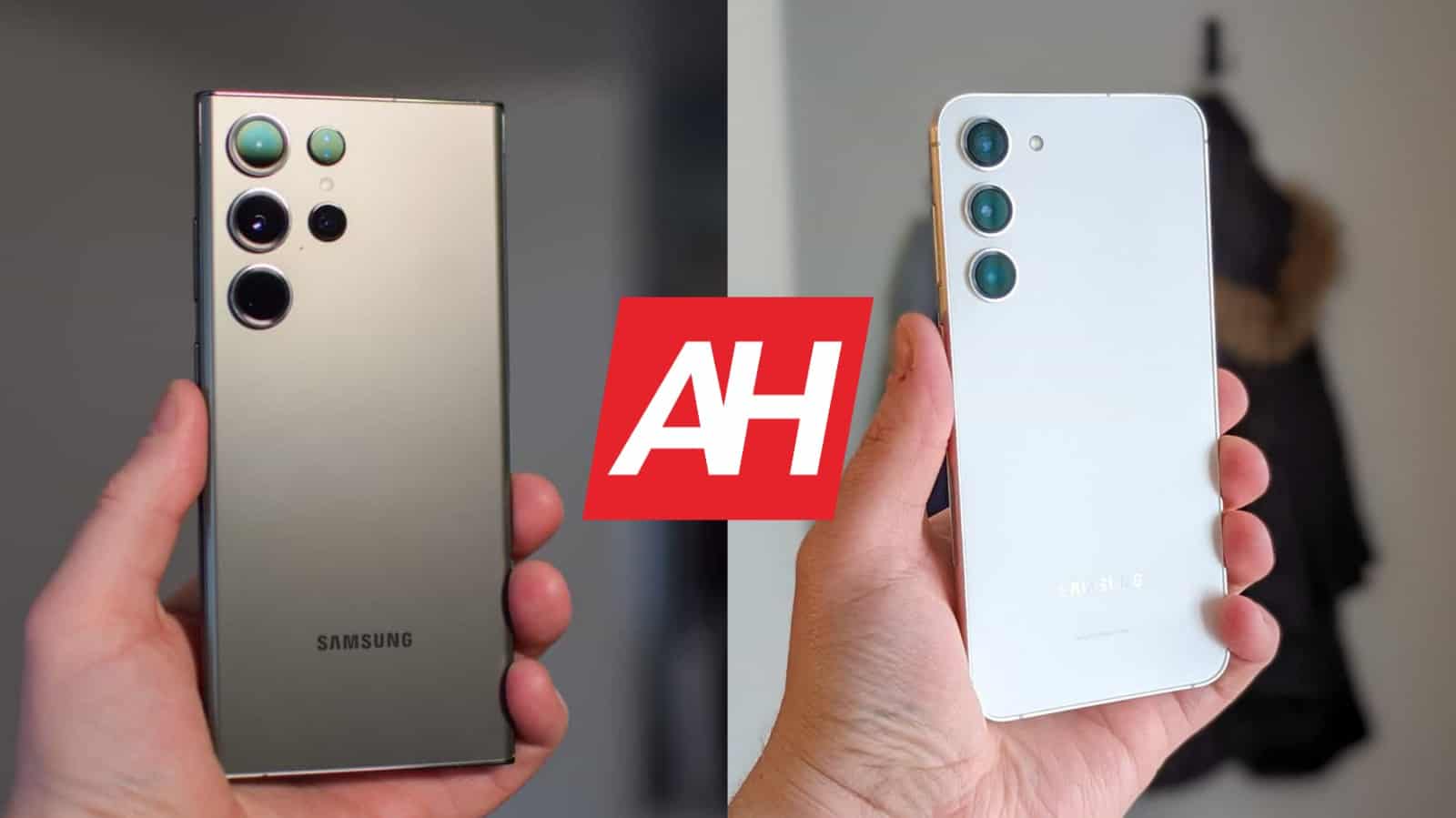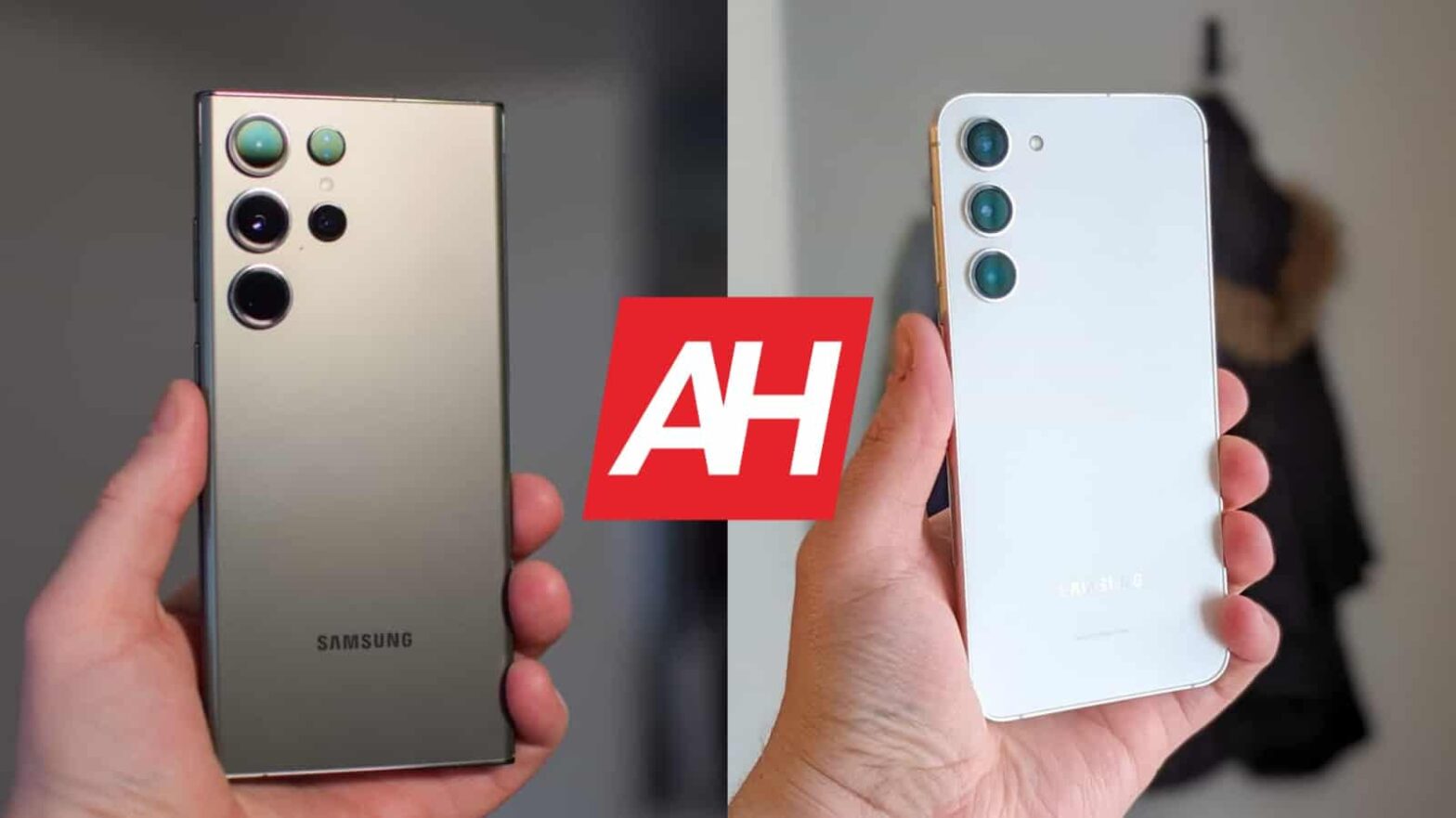Samsung launched three flagship-series phones earlier this month, and we’re here to compare two of them. We’ll compare the Samsung Galaxy S23 Ultra vs Samsung Galaxy S23+ here. These are the two largest new flagship series phones the company announced. They are quite similar in many ways, but there are also some notable differences worth pointing out. They do differ in terms of design, display, cameras, and more.
As per usual, we’ll first list their specifications, and will then move to compare the two phones across a number of categories. We’ll compare their designs, displays, performance, battery life, cameras, and audio performance. We’ve spent quite a bit of time with both phones at this point, so we have a pretty good idea as to what you can expect. That being said, let’s get this party started, shall we?
Specs
Samsung Galaxy S23 Ultra
Samsung Galaxy S23+
Screen size
6.8-inch QHD+ Dynamic AMOLED 2X display (curved, 120Hz adaptive refresh rate, LTPO, down to 1Hz, 1,750 nits peak brightness)
6.6-inch fullHD+ Dynamic AMOLED 2X display (curved, 120Hz adaptive refresh rate, LTPO, 1,750 nits peak brightness)
Screen resolution
3080 x 1440
2340 x 1080
SoC
Qualcomm Snapdragon 8 Gen 2 for Galaxy
Qualcomm Snapdragon 8 Gen 2 for Galaxy
RAM
8GB/12GB (LPDDR5X)
8GB (LPDDR5X)
Storage
256GB/512GB/1TB, non-expandable (UFS 4.0)
256GB/512GB, non-expandable (UFS 4.0)
Rear cameras
200MP (f/1.7 aperture, 24mm lens, 0.6um pixel size, multi-directional PDAF, Laser AF, OIS)
12MP (ultrawide, Dual Pixel AF, 120-degree FoV, f/2.2 aperture, 1.4um pixel size)
10MP (telephoto, Dual Pixel AF, OIS, f/2.4 aperture, 1.12um pixel size, 70mm lens, optical zoom 3x)
10MP (telephoto, Dual Pixel AF, OIS, f/4.9 aperture, 1.22um pixel size, 230mm lens, 10x optical zoom, 100x Space Zoom)
50MP (f/1.8 aperture, 24mm lens, 1.0um pixel size, OIS, Dual Pixel PDAF)
12MP (ultrawide, f/2.2 aperture, 13mm lens, 120-degree FoV, 1.4um pixel size)
10MP (telephoto, f/2.4 aperture, 70mm lens, 1.0um pixel size, OIS, 3x optical zoom, PDAF)
Front cameras
12MP (f/2.2 aperture, 26mm lens, Dual Pixel PDAF)
12MP (f/2.2 aperture, 26mm lens, Dual Pixel PDAF)
Battery
5,000mAh, non-removable, 45W wired charging, 15W Qi wireless charging, 4.5W Wireless PowerShare
Charger not included
4,700mAh, non-removable, 45W wired charging, 15W Qi wireless charging, 4.5W Wireless PowerShare
Charger not included
Dimensions
163.4 x 78.1 x 8.9mm
157.8 x 76.2 x 7.6mm
Weight
234 grams
196 grams
Connectivity
5G, LTE, NFC, Bluetooth 5.3, Wi-Fi, USB Type-C
5G, LTE, NFC, Bluetooth 5.3, Wi-Fi, USB Type-C
Security
In-display fingerprint scanner (ultrasonic)
In-display fingerprint scanner (ultrasonic)
OS
Android 13
One UI 5.1
Android 13
One UI 5.1
Price
$1,199.99/$1,299/$1,399/TBA (1TB)
$1,049/TBA
Buy
Samsung
Samsung
Samsung Galaxy S23 Ultra vs Samsung Galaxy S23+: Design
The moment you lay your eyes on the two phones you’ll notice they’re different. The Galaxy S23 Ultra is flat on both the top and the bottom, unlike the Galaxy S23+. It also has very sharp corners, which is not the case with its sibling, who has rounded corners. They both do include a centered display camera hole, but different displays. The Galaxy S23 Ultra’s is curved, while the Galaxy S22+’s is not. We’ll talk more about displays themselves in the next section.
If we flip the two phones around, you’ll notice that the camera styles are similar, design-wise, but the Galaxy S23 Ultra has more sensors on the back. On both phones, those cameras protrude directly from the backplates. The Galaxy S23 Ultra has curved front and back sides, which is not something we can say for the Galaxy S23+. The phone has flat front and back sides. It is worth noting that the Galaxy S23 Ultra has an S Pen silo in the bottom-left corner. They are both made out of metal (aluminum), and glass.
The Galaxy S23 Ultra is taller, wider, and thicker than the Galaxy S23+. The difference is not major, but it’s noticeable, very much so. The ‘Ultra’ model is also considerably heavier. It weighs 234 grams compared to 196 grams of the Galaxy S23+. Both phones are IP68 certified for water and dust resistance, and both have Gorilla Glass Victus 2 on the back and the front. Yes, they’re both also slippery, and feel completely different in the hand. They both feel large, but the Galaxy S23 Ultra is noticeably more massive. The premium feeling is present when you’re holding both devices, one doesn’t really feel more premium than the other.
Samsung Galaxy S23 Ultra vs Samsung Galaxy S23+: Display
The Galaxy S23 Ultra features a 6.8-inch QHD+ (3088 x 1440) Dynamic AMOLED 2X display. This panel is slightly curved, and it has a 120Hz refresh rate. That refresh rate is adaptive, by the way, to save power. HDR10+ content is supported, and the panel gets immensely bright at 1,750 nits of peak brightness. The Gorilla Glass Victus 2 is included on top of the display for protection reasons.
The Galaxy S23+, on the other hand, includes a 6.6-inch fullHD+ (2340 x 1080) Dynamic AMOLED 2X display. This is also a 120Hz refresh rate, and yes, it’s also an adaptive panel. It supports HDR10+ content, and it gets just as bright as the Galaxy S23 Ultra’s display, when needed. On both phones that is achievable only through adaptive (auto) brightness, though. The Gorilla Glass Victus 2 protects this display as well.
Yes, the Galaxy S23 Ultra’s display is sharper, but the vast majority of people wouldn’t notice that. FullHD+ displays are more than enough, even for such large displays, especially if they’re as good as the Galaxy S23+’s is. Besides, the Galaxy S23 Ultra’s display comes set to fullHD+ resolution out of the box. You can change that, though. Both displays are vivid, sharp, and have excellent viewing angles. The blacks are very deep, and they’re both quite responsive. The Galaxy S23 Ultra’s may be better on paper, but you really can’t go wrong here. If you prefer flat panels, the Galaxy S23+ has an excellent one.
Samsung Galaxy S23 Ultra vs Samsung Galaxy S23+: Performance
When it comes to performance, there’s not much difference between the two. We’re talking about sheer snappiness, of course. The Snapdragon 8 Gen 2 for Galaxy fuels both phones, while both devices include LPDDR5X RAM and UFS 4.0 flash storage. The Galaxy S23 Ultra does offer more RAM, though. In day-to-day performance, they are identical, which is not surprising considering their specs and software.
We did not really spot any lag or anything of the sort during our usage. Quite the contrary, these two phones were easily the snappiest Samsung smartphones we’ve ever used. They open apps fast, multitask like nobody’s business, and are also great for content consumption, etc. Even if you like gaming on your phone, these two will do the trick. Not only is the Snapdragon 8 Gen 2 for Galaxy an excellent SoC, and great for power consumption, but Samsung actually included a proper vapor chamber this time around.
Both smartphones performed great in gaming, even when the most demanding games are concerned. They do get warm, but do not overheat, nor do the games suffer because of it. Performance-wise, they’re on the same level. The Galaxy S23 Ultra does have the advantage of the S Pen, though, of course, but that’s not what we’re talking about here. It’s worth noting, however, of course.
Samsung Galaxy S23 Ultra vs Samsung Galaxy S23+: Battery
What about the battery life, is that also the same? Well, no, not at all. Let’s get the technical stuff out of the way first. The Galaxy S23 Ultra includes a 5,000mAh battery, while the Galaxy S23+ has a 4,700mAh unit on the inside. Based on these battery capacities, and taking other specs into consideration, the two phones should have fairly similar battery life. The Galaxy S23+ does have a smaller display, while most of their internals are identical, and the same goes for software.
Well, the Galaxy S23+ does have really good battery life, but nowhere near the Galaxy S23 Ultra. It’s not even close. Getting up to 9-10 hours of screen-on-time is doable with the Galaxy S23 Ultra, we even went up to 11-12 a couple of times. We were actually amazed at how great that phone’s battery life is. The Galaxy S23+, on the other hand, well, getting up to 8 hours of screen-on-time is possible, at times. The Galaxy S23+ has considerably worse standby battery consumption than the Galaxy S23 Ultra, for whatever reason.
When charging is concerned, both phones support 45W wired charging, in addition to 15W wireless charging, and 4.5W reverse wireless charging. Do note that a charger is not included in the box with either device. This charging is fairly good, as you can get a full charge in around an hour (65% in about 30 minutes), but it’s nowhere near as fast as some of the competition offers.
Samsung Galaxy S23 Ultra vs Samsung Galaxy S23+: Cameras
The Samsung Galaxy S23 Ultra features a 200-megapixel main camera, along with a 12-megapixel ultrawide camera (120-degree FoV), a 10-megapixel telephoto camera (3x optical zoom), and a 10-megapixel periscope telephoto (10x optical zoom) unit. The Galaxy S23+, on the other hand, has a 50-megapixel main camera, a 12-megapixel ultrawide unit (120-degree FoV), and a 10-megapixel telephoto camera (3x optical zoom).
Now, some of you may think that the Galaxy S23 Ultra simply blows the Galaxy S23+ away, based on the review for the ‘Ultra’. That’s not quite the case. In fact, the Galaxy S23+ holds its own really well, and in many cases, the pictures look very similar. In standard mode, both pixel bin to 12-megapixel shots, though the Galaxy S23 Ultra has more info to work with. The pictures do end up looking similar during the day, very similar in fact. In low light, the Galaxy S23+ usually tuned up the brightness just a little bit higher, while the ‘Ultra’ nails the shot most of the time. Both phones tend to provide true-to-life colors for the most part, but at times, they tend to crank up the saturation a bit. They’re both excellent in HDR situations.
The main differentiating factor between them is the 200MP mode on the Galaxy S23 Ultra, and the insane zoom levels the phone offers. If you really need 200MP shots, so that you can zoom in further into the shot while retaining detail, then the Galaxy S23 Ultra is for you. Do note that 200MP shots are huge, and are not exactly as eye-pleasing as 12MP ones. You’ll usually need to spend some time adjusting them. 3x optical zoom is present on both phones, and both of them do a great job in that regard. However, if you go beyond that, the Galaxy S23 Ultra is the winner, no doubt. In fact, shots up to 30x look excellent, as long as there’s light present. Everything over that does drop in quality, but even at 100x, the Galaxy S23 Ultra is truly impressive. There’s not a phone out there that can compete with its periscope telephoto camera performance at the moment.
Audio
Both of these phones have a set of stereo speakers, but they do not have an audio jack. Those speakers are really good on both phones, and quite frankly we didn’t really notice a difference sound-wise. Both sets of speakers are tuned by AKG, and are louder than their predecessors. The sound is good, and there’s even some bass included.
If you want to connect your headphones via a wire, you’ll have to use a Type-C port. Neither phone includes an audio jack. Both do support Bluetooth 5.3, though, in case you prefer wireless audio connections.
The post Phone Comparisons: Samsung Galaxy S23 Ultra vs Samsung Galaxy S23+ appeared first on Android Headlines.

Source: ndroidheadlines.com
